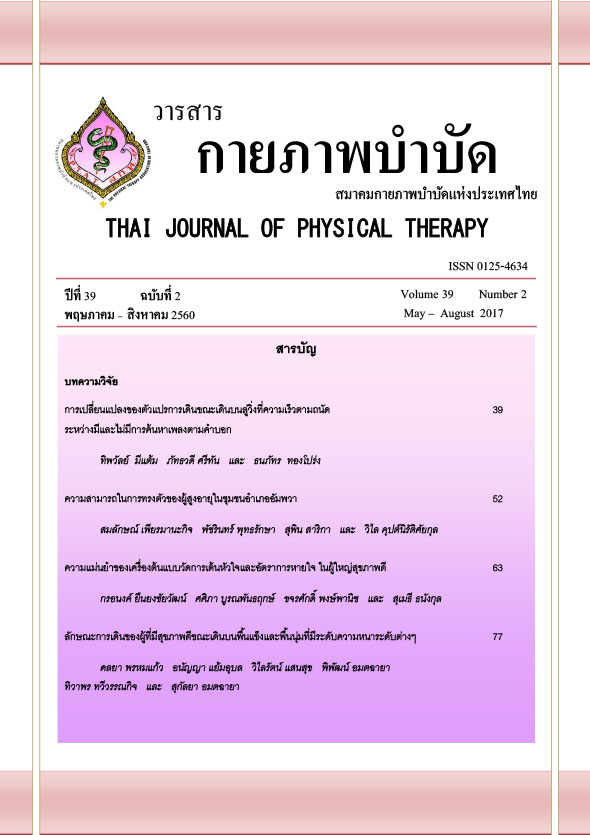ลักษณะการเดินของผู้ที่มีสุขภาพดีขณะเดินบนพื้นแข็งและพื้นนุ่มที่มีระดับความหนาระดับต่างๆ
Main Article Content
บทคัดย่อ
ที่มาและความสำคัญ: พื้นนุ่มส่งผลให้เกิดความไม่มั่นคงซึ่งท้าทายความสามารถด้านการเดินแต่ปัจจุบันยังไม่มีรายงานผลของพื้นนุ่มและระดับความหนาที่ส่งผลต่อลักษณะการเดิน
วัตถุประสงค์: เพื่อศึกษาลักษณะการเดินของอาสาสมัครสุขภาพดีจำนวน 16 คนขณะเดินบนพื้นนุ่มหนา 1 นิ้ว และหนา 3 นิ้ว เปรียบเทียบการเดินบนพื้นเรียบแข็ง
วิธีการ: อาสาสมัคร (อายุเฉลี่ย26±2.85 ปี) ได้รับการประเมินความเร็วในการเดิน ความถี่การก้าวขา ความยาวรอบการเดิน และความสมมาตรของระยะก้าว ขณะเดินบนพื้นแต่ละแบบด้วยความเร็วปกติและความเร็วสูงสุด อย่างละ 3 รอบ ผู้วิจัยบันทึกภาพการเดินของอาสาสมัครเพื่อวิเคราะห์การเคลื่อนไหวแบบ 2 มิติโดยใช้โปรแกรม Kinovea ใช้สถิติ ANOVA with repeated measure เพื่อเปรียบเทียบค่าเฉลี่ยของตัวแปรขณะเดินบนพื้นแต่ละแบบ กำหนดระดับนัยสำคัญที่ p<0.05
ผลการศึกษา: เมื่อเดินบนพื้นนุ่มอาสาสมัครเดินและก้าวขาช้าลงกว่าการเดินบนพื้นเรียบแข็งอย่างมีนัยสำคัญทางสถิติทั้งเมื่อเดินด้วยความเร็วปกติและความเร็วสูงสุด (ความเร็วในการเดิน = 1.12-1.35 เมตร/วินาที และ 1.34-1.74 เมตร/วินาทีความถี่การก้าวขา = 96-110ก้าว/นาที และ 120-139 ก้าว/นาที เมื่อเดินบนพื้นนุ่มและพื้นเรียบแข็งด้วยความเร็วปกติและความเร็วสูงสุดตามลำดับ p<0.05) แต่ไม่พบความแตกต่างของตัวแปรอื่นรวมถึงไม่พบความแตกต่างระหว่างการเดินบนพื้นนุ่มหนา 1 นิ้วและหนา 3 นิ้ว (p>0.05)
สรุปการศึกษา: พื้นนุ่มท้าทายความสามารถด้านการเดินโดยเฉพาะในตัวแปรที่เกี่ยวข้องกับเวลา โดยการประยุกต์ใช้ทางคลินิกอาจเลือกใช้พื้นนุ่มหนา 1 นิ้ว เนื่องจากมีน้ำหนักเบา ราคาถูก จัดเก็บง่าย และขนย้ายได้สะดวกกว่าพื้นนุ่มหนา 3 นิ้ว อย่างไรก็ตาม ข้อมูลที่ได้เป็นการศึกษาเบื้องต้นในอาสาสมัครสุขภาพดี ดังนั้น การศึกษาในอนาคตควรเปรียบเทียบข้อมูลในอาสาสมัครที่มีความบกพร่องทางการเคลื่อนไหวเพื่อยืนยันการประยุกต์ใช้พื้นนุ่มในการฟื้นฟูความสามารถทางคลินิกได้ดียิ่งขึ้น
Article Details
เอกสารอ้างอิง
2. Sawachaa Z, Spolaora F, Guarnerib G, et al. Abnormal muscle activation during gait in diabetes patients with and without neuropathy. Gait Posture 2012; 35: 101-5.
3. Boonstra TA, van der Kooij H, Munneke M, Bloem BR. Gait disorders and balance disturbances in Parkinson's disease: clinical update and pathophysiology. CurrOpinNeurol 2008; 21: 461-71.
4. Behrman A, Harkema S. Locomotor training after human spinal cord injury: a series of case studies. Phys Ther 2000; 80: 688-700.
5. Amatachaya S, Kaewsutthi M. Gait rehabilitation for patients with incomplete spinal cord injury (iSCI): conventional and treadmill training. J Med Tech Phys Ther 2007; 19: 7-19.
6. Behrman AL, Bowden MG, Nair PM. Neuroplasticity after spinal cord injury and training: an emerging paradigm shift in rehabilitation and walking recovery. Phys Ther 2006; 86: 1406-25.
7. Morrison K, Braham RA, Dawson B, Guelfi K. Effect of a sand or firm-surface walking program on health, strength, and fitness in women 60-75 years old. J Aging Phys Act 2009; 17: 196-209.
8. Pinnington HC, Dawson B. The energy cost of running on grass compared to soft dry beach sand. J Sci Med Sport 2001; 4: 416-30.
9. Lejeune TM, Willems PA, Heglund NC. Mechanics and energetics of human locomotion on sand. J ExpBiol 1998; 201: 2071-80.
10. National Spinal Cord Injury Statistical Center. Spinal cord injury facts and figures at a glance. J Spinal Cord Med 2013; 36: 568-9.
11. Cardenas DD, Hoffman JM, Kirshblum S, McKinley W. Etiology and incidence of rehospitalization after traumatic spinal cord injury: a multicenter analysis. Arch Phys Med Rehabil 2004; 85: 1757-63.
12. Pramodhyakul N, Amatachaya P, Sooknuan T, Arayawichanon P, Amatachaya S. Visuotemporal cues clinically improved walking ability of ambulatory patients with spinal cord injury within 5 days. J Spinal Cord Med 2016; 39:405-11.
13. Kumprou M, Amatachaya P, Sooknuan T, Thaweewannakij T, Mato L, Amatachaya S.Do ambulatory patients with spinal cord injury walk symmetrically? Spinal Cord 2016; 55; 204-7.
14. Kumprou M, Amatachaya P, Sooknuan T, Thaweewannakij T, Amatachaya S. Is walking symmetry important for ambulatory patients with spinal cord injury? Disabil Rehabil 2017; 1-9
15. Kirtley C. Clinical gait analysis: theory and practice. Edinburgh: Livingstone; 2006.
16. Balasubramanian CK, Bowden MG, Neptune RR, Kautz SA. Relationship between step length asymmetry and walking performance in subjects with chronic hemiparesis. Arch Phys Med Rehabil 2007; 88: 43-9.
17. Patterson KK, Gage WH, Brooks D, Black SE, McIlroy WE. Evaluation of gait symmetry after stroke: a comparison of current methods and recommendations for standardization. Gait Posture 2010; 31: 241-6.


